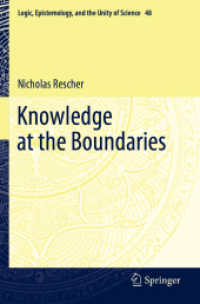- ホーム
- > 洋書
- > 英文書
- > Juvenile Grades 10-12
Full Description
Improve your students' scientific skills and report writing with achievable experiments and simple structured guidance.This Laboratory Practical Book supports the teaching and learning of the practical assessment element of the Cambridge IGCSE Chemistry Syllabus. Using this book, students will interpret and evaluate experimental observations and data. They will also plan investigations, evaluate methods and suggest possible improvements.- Demonstrates the essential techniques, apparatus, and materials that students require to become accomplished scientists- Improves the quality of written work with guidance, prompts and experiment writing frames - Develops experimental skills and abilities through a series of investigations- Prepares students for the Practical paper or the Alternative, with past exam questionsAnswers are available on the Teacher's CD:http://www.hoddereducation.co.uk/Product?Product=9781444196290This title has not been through the Cambridge International endorsement process.
Contents
10.1: Safety 0.2: Using and organizing apparatus and materials0.3: Observing, measuring and recording 0.4: Handling experimental observations and data0.5: Planning, carrying out and evaluating investigations 1: EXPERIMENTS1: The particulate nature of matter 1.1: Rate of diffusion of ammonia and hydrogen chloride1.2: Reaction of potassium iodide with lead(II) nitrate1.3: Sublimation of iodine2: Elements, compounds and experimental techniques2.1: Rock salt an important raw material2.2: Ascending chromatography2.3: Elements, mixtures and Compounds3: Atomic structure and bonding3.1: Structure of substances3.2: Properties of ionic and covalent substances3.3: Electrolysis of solutions4: Stoichiometry - chemical calculations4.1: Determination of the formula of magnesium oxide4.2: Determination of the volume occupied by one mole of a gas4.3: Determination of the percentage yield of a chemical reaction5: Electricity and chemistry5.1: Electrolysis of molten lead bromide5.2: Electrolysis of water5.3: Electrolysis of brine6: Chemical energetics6.1: Electrochemical cells - Chemical energy to electrical energy6.2: Calculating the energy of combustion of methanol and ethanol6.3: Determination of the energy change of a displacement reaction7: Chemical reactions7.1: How does changing surface area effect the rate of a reaction?7.2: What is the effect of changing the temperature of the rate of a reaction?7.3: What is the effect of changing the concentration on the rate of a reaction?8: Acids, bases and salts8.1: Hydrated salts - How much water do they contain?8.2: Determination of the concentration of a solution of hydrochloric acid8.3: Preparation of hydrated magnesium sulfate9: The Periodic Table9.1: Reactions of Group 1 Metals9.2: Halogen displacement reactions9.3: Using transition metals as catalysts10: Metals10.1: Metal displacement reactions10.2: Rusting of iron10.3: Metal reactivity11: Air and water11.1: Active part of the air11.2: Making a fertiliser11.3: The effects of acid rain12: Sulfur12.1: Sulfuric acid a useful quantitative analytical chemical12.2: Concentrated sulfuric acid12.3: Props of dilute sulfuric acid13: Inorganic carbon chemistry13.1: Limestone - a useful resource13.2: Does the food we eat contain carbon?13.3: Carbon dioxide14: Organic chemistry 114.1: Is methane a hydrocarbon?14.2: Difference between alkanes and alkenes14.3: Hydrocarbons can form isomers15: Organic chemistry 215.1: Organic structures and functional groups15.2: Nylon rope trick15.3: Properties of dilute ethanoic acid16: Experimental chemistry16.1: Missing labels from reagent bottles - what a problem!16.2: Using flame colours to identify unknown metal ions16.3: How pure is your water supply?








